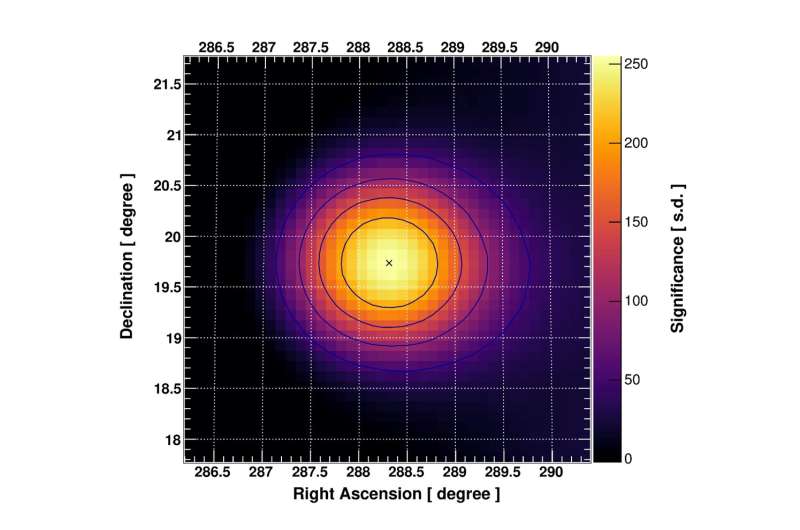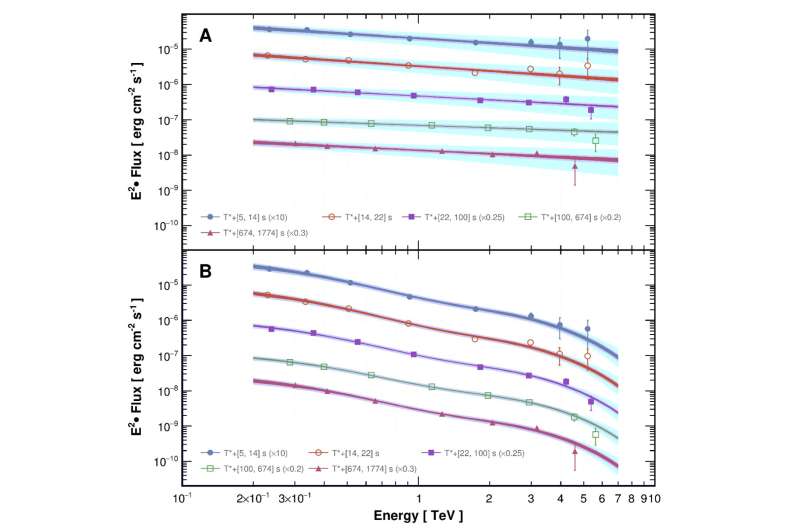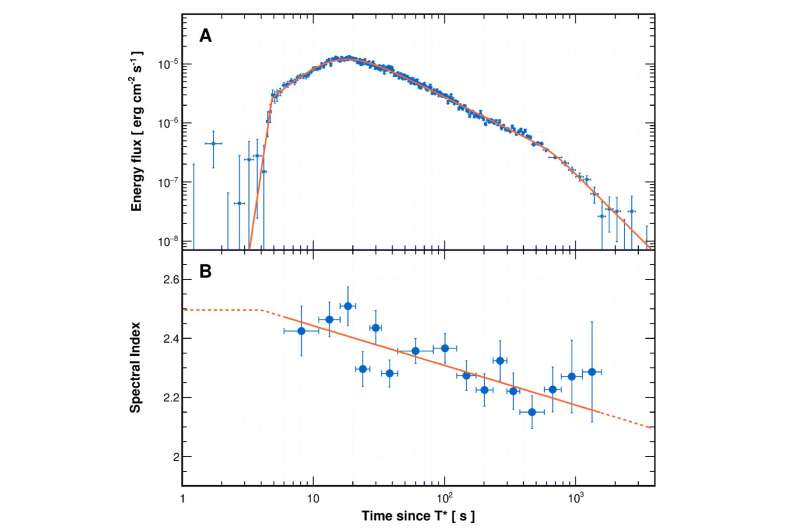This article has been reviewed according to Science X's editorial process and policies. Editors have highlighted the following attributes while ensuring the content's credibility:
fact-checked
peer-reviewed publication
trusted source
proofread
Recording the entire process of a tera-electron volt gamma-ray burst during the death of a massive star

New research findings on the gamma-ray burst (GRB) named GRB 221009A from the Large High Altitude Air Shower Observatory (LHAASO) were published online by the journal Science on June 8, 2023. The study, titled "A tera-electron volt afterglow from a narrow jet in an extremely bright GRB 221009A," was completed by the LHAASO international collaboration.
About two billion years ago, a massive star more than 20 times heavier than the sun used up the fusion energy from its nuclear fuel, instantly collapsed, and triggered a massive explosion, thus unleashing a collimated burst of cosmic fireworks known as a gamma-ray burst (GRB) that lasted hundreds of seconds.
The high-energy gamma-ray photons, generated from the collision between the fireball and interstellar matter, traveled through the vast universe and headed straight toward Earth. In the evening of October 9, 2022, at 13:20:50 UT, these photons reached the field of view of LHAASO, where over 60,000 gamma-ray photons were collected. After several months of analysis, scientists finally unveiled the details of this explosion event.
LHAASO precisely measures for the first time the entire light curve of high-energy photons from the afterglow of a GRB
The flux of photons collected by LHAASO indicates that they came from the radiation following the main burst. The main burst, namely the prompt emission, is the initial massive explosion characterized by intense low-energy gamma-ray radiation. The following burst, known as the afterglow, is produced when the ejected matter collides with the surrounding interstellar gas at speeds very close to the speed of light.
"LHAASO accurately measured the complete process of the afterglow for the first time, comprising the entire phase of tera-electron volt gamma-ray flux from rise to decay," said Cao Zhen, principal investigator of the LHAASO project, spokesperson for the LHAASO collaboration, and professor at the Institute of High Energy Physics (IHEP) of the Chinese Academy of Sciences.

Based on the observation of tens of thousands of GRBs, scientists have developed seemingly perfect theoretical models and have strong confidence in them. LHAASO observed the complete high-energy light curve that other experiments have yet to reach, providing a perfect data base for precise tests of these theoretical models. Given the rarity of this event, which probably occurs only once a millennium, it is expected that this observed result will remain one of the best for the next several decades or even centuries.
LHAASO measures for the first time the rapid enhancement process of high-energy photon flux from a GRB
"At the beginning of onset of the afterglow, LHAASO detected for the first time the extremely rapid enhancement of photon flux," said Yao Zhiguo, a professor at IHEP and one of the corresponding authors of the paper. Within a time interval of less than two seconds, the flux increased by a factor of more than one hundred, followed by a slow rise that conforms to the expected characteristics of an afterglow. The early rapid enhancement phenomenon exceeds the expectations of previous theoretical models.
This leads to a question: What mechanisms are actually at play. The published results would spark in-depth discussions within the scientific community regarding the mechanisms involved in GRBs, including energy injection, photon absorption, and particle acceleration.

LHAASO unveils the mystery of the brightness of the brightest-of-all-time GRB
LHAASO observations have shown that high-energy radiation decreases more rapidly in brightness around 10 minutes after the start of the afterglow. "This can be explained by the fact that the ejected material after the explosion forms a jet-like structure, and the rapid decrease in brightness occurs when the radiation angle extends to the edge of the jet," said Wang Xiangyu, a professor at Nanjing University and one of the corresponding authors of the paper. Due to the extremely early occurrence of this brightness transition, the measured angle of the jet is inferred to be extremely small, only 0.8 degrees.
This is the smallest known jet angle to date, indicating that what was observed is actually the brightest core of a typical internally bright and externally dark jet. "The observer happens to be directly facing the brightest core of the jet, and it naturally explains why this gamma-ray burst is the brightest in history and why such an event is so rare," said Dai Zigao, a professor at the University of Science and Technology of China of CAS and one of the corresponding authors of the paper.
LHAASO's data-intensive observations at high-energy will reveal more mysteries
Within the short duration of this event, the number of photons LHAASO recorded exceeded the cumulative number of photons observed from the "standard candle" Crab Nebula over the past few years. "If the selection criteria were slightly relaxed, the photon count could even reach 100,000!" said Zha Min, a professor at IHEP and one of the corresponding authors of the paper.
As a comparison, other instruments in the similar energy band had detected less than 1000 photons in other GRBs so far, and they are only able to detect photons tens of seconds after the burst." As of now, there are still many unknowns in this burst event, and LHAASO scientists are still analyzing the data, in order to reveal more secrets. Please stay tuned for the subsequent analysis results from LHAASO," said Prof. Cao.
More information: Cao Zhen et al, A tera–electron volt afterglow from a narrow jet in an extremely bright gamma-ray burst, Science (2023). DOI: 10.1126/science.adg9328
Journal information: Science
Provided by Chinese Academy of Sciences





















